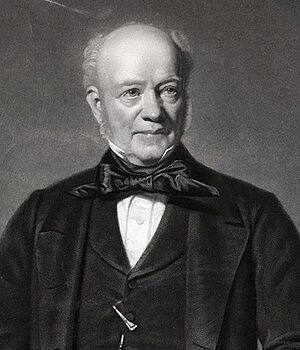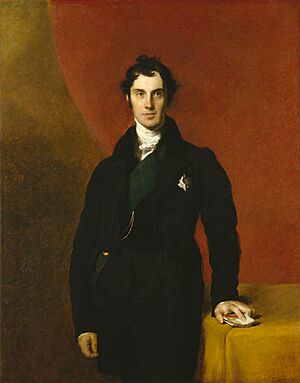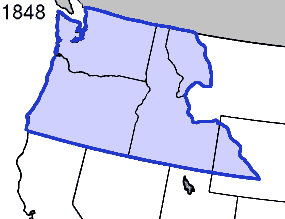Oregon boundary dispute facts for kids
The Oregon boundary dispute was a big disagreement in the 1800s. It was about who owned a large area of land in the Pacific Northwest of North America. Several countries wanted this land because it was rich in resources and good for trade.
At first, the Russians, British, Spanish, and Americans all had claims. But after a while, Russia and Spain gave up their claims. This left Great Britain and the United States to argue over the land. The disputed area was called the Columbia District by the British and Oregon Country by the Americans. It stretched from 42°N (north of California) to 54°40′N (south of Russian Alaska).
During the 1844 US presidential election, the Democratic Party wanted to claim all of this land. Their candidate, James K. Polk, used the idea of "Manifest Destiny". This was a belief that the US was meant to expand across the continent. Polk won the election. He then offered to divide the land with Britain along the 49th parallel. But negotiations were tough. The British wanted the border to be along the Columbia River.
Tensions grew, and some Americans used the slogan "Fifty-four Forty or Fight!" This meant they wanted all the land up to 54°40′N, or they would fight for it. However, the US was also having problems with Mexico over Texas. President Polk didn't want to fight two wars at once. So, he went back to his earlier idea of the 49th parallel as the border.
In 1846, the Oregon Treaty was signed. It set the border between British North America (now Canada) and the United States at the 49th parallel. This line went all the way to the Strait of Georgia. However, Vancouver Island and the Gulf Islands stayed British. The treaty also left some confusion about the San Juan Islands. This led to a small conflict called the Pig War. In 1872, a German ruler helped settle this, giving the islands to the United States. This border is still the one between the US and Canada today.
Contents
Early Claims to the Pacific Northwest
The argument over Oregon started in the 1700s. European and American explorers began to visit the Pacific Northwest. They saw it as a good place to expand their empires. Spanish, British, American, and Russian explorers all claimed parts of the area.
Naval captains like Spain's Juan José Pérez Hernández and Britain's George Vancouver explored the coast. They named important places like the Columbia River and Puget Sound. Overland explorers like Britain's Alexander Mackenzie and America's Lewis and Clark also explored the land. They often claimed the land for their home countries.
People were interested in the area because of its fur-bearing animals. Animals like sea lions and beavers were valuable for the fur trade. Merchants traded goods with Native American groups like the Chinookan people for furs. This trade was the main reason Europeans and Americans came to the Pacific Northwest for many years.
Spain's Early Presence
Spain sent several expeditions to the Pacific Northwest. They wanted to strengthen their claims. They even started a colony called Santa Cruz de Nuca on Vancouver Island. This was the first European colony in the area outside of Russian Alaska.
There was a time of tension with Britain called the Nootka Crisis. This happened after Spain seized a British ship. But agreements called the Nootka Conventions prevented a war. Both countries agreed to share access to Friendly Cove. Spain later left its colony. In 1819, Spain officially gave up all its claims to land north of the 42° north in the Adams–Onís Treaty.
Russia's Interest in the Region
The Russian Empire created the Russian-American Company in 1799. This company had a monopoly on fur trading in Russian America (Alaska). Russia also thought about starting colonies further south. But their efforts to explore the Columbia River failed.
The Russians decided that much of the Northwest coast wasn't worth colonizing. They focused more on Alta California (part of Mexico), where they built Fort Ross. In 1824 and 1825, Russia signed treaties with the US and Britain. These treaties set the southern border of Russian America at 54°40′ north. This meant Russia would not settle south of that line, and the US would not settle north of it.
Early British and American Competition
By the 1810s, Russia and Spain were less interested in colonizing the Northwest Coast. This left Britain and the United States as the main competitors. British fur traders from the North West Company (NWC) started land-based operations in 1807. They built trading posts throughout the region. David Thompson explored the Columbia River area. In 1811, he claimed the land for Great Britain.
The American Pacific Fur Company (PFC) started in 1811 at Fort Astoria on the Columbia River. When the War of 1812 broke out, the PFC sold its assets to the NWC. After the PFC collapsed, American fur traders (called mountain men) worked in small groups. They usually stayed east of the Rocky Mountains.
Sharing the Land: Joint Occupation
In 1818, the US and Britain tried to agree on a border. The Americans wanted to divide the land along the 49th parallel. This was already the border east of the Rocky Mountains. The British wanted the border further south, along the Columbia River. This would help the North West Company (and later the Hudson's Bay Company (HBC)) control the fur trade.
They couldn't agree. So, they signed the Treaty of 1818. This treaty said that both countries would jointly occupy the region for ten years. This meant people from both countries could live and trade there.
Plans for Dividing the Land
As the ten-year agreement was ending, new talks began in 1824. The US suggested a temporary border at the 51° parallel. No British settlements would be south of it, and no American settlements north of it. The British rejected this. They wanted a permanent border along the 49th parallel, but then curving south along the main branch of the Columbia River. This would give Britain control of what is now western Washington and southern Vancouver Island.
The US didn't like this idea. They wanted access to a good deep-water port on the Pacific Ocean. The British offered the Olympic Peninsula to the US for a port, but the Americans still said no. The talks failed, and the joint occupation treaty was renewed in 1827. It included a rule that either side had to give one year's notice to end the agreement.
American Interest Grows
American missionaries started arriving in the 1830s. They set up missions in the Willamette Valley and east of the Cascades. American settlers also started to arrive. In 1843, over 700 US settlers came on the Oregon Trail. These settlers formed the Provisional Government of Oregon in the Willamette Valley.
The 1844 Presidential Election
The 1844 US presidential election was a big moment for the Oregon dispute. The Democrats wanted to annex (add) Texas to the US. They also said that the US had a "clear and unquestionable" right to all of Oregon. They linked these two ideas to appeal to voters who wanted the US to expand.
James K. Polk, the Democratic candidate, won the election. He defeated Henry Clay of the Whig Party. Clay was against immediate expansion in Texas. Even though Oregon was used in the election, some historians say it wasn't the main reason Polk won.
"Fifty-four Forty or Fight!"
The famous slogan "Fifty-four Forty or Fight!" became popular in 1846. It wasn't actually a slogan from Polk's 1844 campaign. It meant that Americans wanted the border to be at 54°40′ north, or they were ready to go to war. This line was the southern border of Russian America (Alaska).
The actual border of Alaska is still 54°40′ north today. British Columbia (part of Canada) was created in 1858.
British Concerns and Actions

The Hudson's Bay Company (HBC) was very important to British interests. It merged with the North West Company in 1821. The HBC had a license to trade furs with Native American groups in the region. Its main base was at Fort Vancouver (in modern Vancouver, Washington).
By the late 1830s, Fort Vancouver was a large operation. It oversaw many trading posts, ports, and ships. The HBC manager, George Simpson, thought that if Americans settled at the mouth of the Columbia River, the company might have to move its operations northward.
The Royal Navy sent ships to the Pacific Northwest to map the area and protect British fur trading posts. The British had a naval base in Valparaíso, Chile, which helped them send ships to the region.
In 1844, HMS Modeste arrived at the Columbia River. It stayed at Fort Vancouver for a long time. American settlers in the Willamette Valley were not happy about a large warship being there. But relations improved when the officers held dances and theatrical shows.
Other British ships, like HMS Fisgard and HMS Cormorant, were sent to the area in 1846. They helped protect British interests and map the coast.
Polk's Presidency and Rising Tensions
In his speech in March 1845, President Polk said that the US claim to Oregon was "clear and unquestionable." Tensions grew, and both sides prepared for possible war. But Polk actually wanted to find a compromise. He believed that taking a strong stance would make the British agree to a deal.
Many US newspapers wanted Polk to claim all of Oregon. They used headlines like "The Whole of Oregon or None." The term "Manifest Destiny" became very popular. It described the idea that the US was meant to expand across the continent.
British diplomats were influenced by HBC officials. They wanted the border to be along the Columbia River. They even offered the US naval bases on Vancouver Island south of the 49th parallel.
In the summer of 1845, Polk's government offered to divide Oregon along the 49th parallel. They also offered Britain any ports they wanted on Vancouver Island south of this line. But the British ambassador rejected this without asking London first. Polk was offended and withdrew his offer. He refused to restart talks.
Averting War

In December 1845, Polk asked Congress to end the joint occupation agreement. Some Democrats in Congress wanted war with Britain to get all of Oregon up to 54°40′ north. They didn't trust the British and believed the US had a stronger claim.
However, many people, including moderates like Daniel Webster, warned that the US could not win a war against the powerful British Empire. They believed negotiation was the best way. Webster said it would be "stupendous folly and enormous crime" to go to war over the Pacific Northwest.
Britain's Foreign Secretary, Lord Aberdeen, did not want war over Oregon. The region was becoming less important to Britain economically. Also, the United States was a key trading partner, especially with a famine in Ireland starting. Britain had a very strong navy, which gave them an advantage. The US knew that Britain could send many warships to the Atlantic coast.
The US minister in Britain, Louis McLane, reported that the British were ready to send many ships to sea. Polk's strong stance had been met with a strong British response.
Congress finally approved a resolution in April 1846 to end the joint occupation. But it was a mild resolution, asking both governments to settle the matter peacefully. Most members of Congress, like Polk, did not want to fight for 54°40′.
The British government, led by Robert Peel, was about to change. So, there was a rush to settle the dispute. A costly war with a major trading partner was not popular with the British government. Lord Aberdeen and McLane quickly worked out a compromise.
The Oregon Treaty

A formal agreement, called the Oregon Treaty, was signed. The US Senate approved it on June 18, 1846. The border on the mainland was set at the 49th parallel. This was the original US proposal. British subjects living in the area were allowed to use the Columbia River for navigation.
The treaty ended the joint occupation. Most people in Oregon south of the 49th parallel became US citizens. Some historians believe the treaty was fair to both sides. It gave Britain good harbors and resources like minerals, timber, and fish. The US received more farmland and a better climate.
The treaty's wording about the water boundary was unclear. It said the border would follow "the deepest channel" to the Strait of Juan de Fuca. This left the ownership of the San Juan Islands uncertain. After the "Pig War" in 1859, Kaiser William I of Germany helped settle the dispute in 1872. He decided that the islands belonged to the United States.
The border set by the Oregon Treaty and finalized in 1872 is still the boundary between the United States and Canada in the Pacific Northwest today.
Images for kids
-
Representative John Floyd was an early supporter of American claims in the Pacific Northwest.
-
Senator Lewis Cass was a strong supporter of the 54°40′ claim, but later changed his mind.






